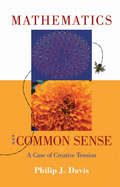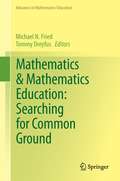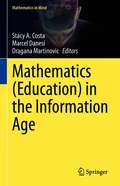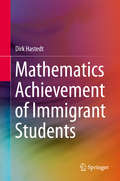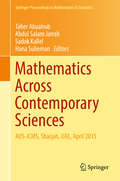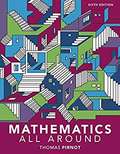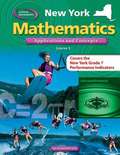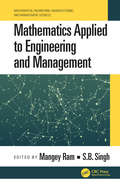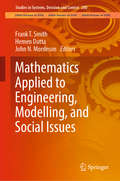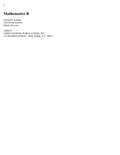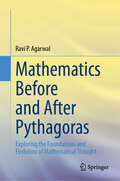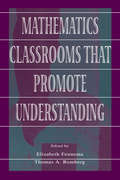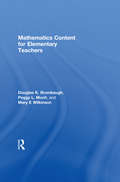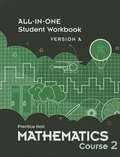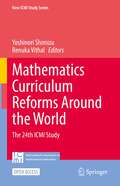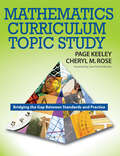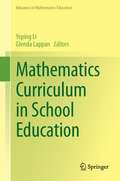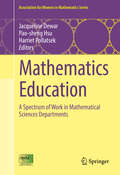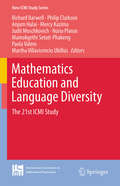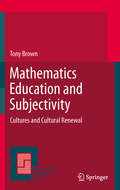- Table View
- List View
Mathematics & Common Sense: A Case of Creative Tension
by Philip J. DavisFrom the Preface: This book is addressed to all who are curious about the nature of mathematics and its role in society. It is neither a text book nor a specialists' book. It consists of a number of loosely linked essays that may be read independently and for which I have tried to provide a leitmotif by throwing light on the relationship between mathematics and common sense. In these essays I hope to foster a critical attitude towards both the existence of common sense in mathematics and the ambiguous role that it can play.
Mathematics & Mathematics Education: Searching for Common Ground
by Michael N. Fried Tommy DreyfusThis book is the fruit of a symposium in honor of Ted Eisenberg concerning the growing divide between the mathematics community and the mathematics education community, a divide that is clearly unhealthy for both. The work confronts this disturbing gap by considering the nature of the relationship between mathematics education and mathematics, and by examining areas of commonality as well as disagreement. It seeks to provide insight into the mutual benefit both stand to gain by building bridges based on the natural bonds between them.
Mathematics (Mathematics in Mind)
by Marcel Danesi Dragana Martinovic Stacy A. CostaThis book brings together ideas from experts in cognitive science, mathematics, and mathematics education to discuss these issues and to present research on how mathematics and its learning and teaching are evolving in the Information Age. Given the ever-broadening trends in Artificial Intelligence and the processing of information generally, the aim is to assess their implications for how math is evolving and how math should now be taught to a generation that has been reared in the Information Age. It will also look at the ever-spreading assumption that human intelligence may not be unique—an idea that dovetails with current philosophies of mind such as posthumanism and transhumanism. The role of technology in human evolution has become critical in the contemporary world. Therefore, a subgoal of this book is to illuminate how humans now use their sophisticated technologies to chart cognitive and social progress. Given the interdisciplinary nature of the chapters, this will be of interest to all kinds of readers, from mathematicians themselves working increasingly with computer scientists, to cognitive scientists who carry out research on mathematics cognition and teachers of mathematics in a classroom.
Mathematics A
by Isidore Dressler Edward P. KeenanThis text has been written to provide effective teaching materials for a unified program appropriate for ninth- and tenth-grade mathematics students, including all topics contained in the Core Curriculum.
Mathematics Achievement of Immigrant Students
by Dirk HastedtThis book examines the mathematics achievement of immigrant students on the basis of data from the IEA Trends in International Mathematics and Science Study (TIMSS). It combines an analysis of large-scale assessment data with an in-depth exploration of policy studies and transforms the insights gained into recommendations on how to promote better education for students with an immigrant background. In a world defined by globalization, education systems face the challenge of providing high-quality education for an increasing number of immigrant students. This book addresses topical questions, such as the circumstances and policies that promote good education, and why some countries are more successful than others in catering for the needs of this very diverse group of students. It provides details on the differences between immigrants and non-immigrants in education, includes case studies on policies of two "successful" countries, and gives hints to policy makers for policies that can help improve the situation for immigrant students in schools.
Mathematics Across Contemporary Sciences
by Sadok Kallel Taher Abualrub Abdul Salam Jarrah Hana SuliemanThis work presents invited contributions from the second "International Conference on Mathematics and Statistics" jointly organized by the AUS (American University of Sharjah) and the AMS (American Mathematical Society). Addressing several research fields across the mathematical sciences, all of the papers were prepared by faculty members at universities in the Gulf region or prominent international researchers. The current volume is the first of its kind in the UAE and is intended to set new standards of excellence for collaboration and scholarship in the region.
Mathematics All Around
by Tom PirnotGiven their widely varying backgrounds, students in Liberal Arts Math often enter the course with math anxiety. Pirnot’s Mathematics All Around, 6th Edition offers the supportive and patient writing style that students need to overcome that apprehension, developing useful skills through realistic applications that can be seen in the world around them. Relevant and approachable, the author’s tone resembles the support students would receive during an instructor’s office hours. The author emphasizes a problem-solving approach, reinforcing problem-solving methods and how to apply them throughout the text. The 6th Edition keeps students engaged with updated real-world applications, while also providing more support as they learn with new measurable objectives, revised exercise sets, significant enhancements to each chapter, as well as a new student Workbook.
Mathematics Application and Concepts: Course 3 (New York Edition)
by McGraw-HillYour textbook also gives you many opportunities to master the Mathematics Performance Indicators. Take time each day to do at least one sample problem either from the Countdown or from the lesson you are studying.
Mathematics Applied to Engineering and Management (Mathematical Engineering, Manufacturing, and Management Sciences)
by Mangey Ram and S. B. SinghThis book offers the latest research advances in the field of mathematics applications in engineering sciences and provides a reference with a theoretical and sound background, along with case studies. In recent years, mathematics has had an amazing growth in engineering sciences. It forms the common foundation of all engineering disciplines. This new book provides a comprehensive range of mathematics applied to various fields of engineering for different tasks in fields such as civil engineering, structural engineering, computer science, electrical engineering, among others. It offers articles that develop the applications of mathematics in engineering sciences, conveys the innovative research ideas, offers real-world utility of mathematics, and plays a significant role in the life of academics, practitioners, researchers, and industry leaders. Focuses on the latest research in the field of engineering applications Includes recent findings from various institutions Identifies the gaps in the knowledge of the field and provides the latest approaches Presents international studies and findings in modelling and simulation Offers various mathematical tools, techniques, strategies, and methods across different engineering fields
Mathematics Applied to Engineering, Modelling, and Social Issues (Studies in Systems, Decision and Control #200)
by John N. Mordeson Hemen Dutta Frank T. SmithThis book presents several aspects of research on mathematics that have significant applications in engineering, modelling and social matters, discussing a number of current and future social issues and problems in which mathematical tools can be beneficial. Each chapter enhances our understanding of the research problems in a particular an area of study and highlights the latest advances made in that area. The self-contained contributions make the results and problems discussed accessible to readers, and provides references to enable those interested to follow subsequent studies in still developing fields. Presenting real-world applications, the book is a valuable resource for graduate students, researchers and educators. It appeals to general readers curious about the practical applications of mathematics in diverse scientific areas and social problems.
Mathematics Before and After Pythagoras: Exploring the Foundations and Evolution of Mathematical Thought
by Ravi P. AgarwalThis book provides the reader with a comprehensive account of the contributions of Pythagoras to mathematics and philosophy, using them as a starting point to compare pre-Pythagorean accomplishments with the myriad mathematical developments that followed. It begins with a thorough study of Pythagoreanism and the early Pythagoreans, including the major events in Pythagoras' life and the origins of the mystical significance attributed by Pythagoreans to natural numbers. From Chapter 3 onward, the book describes how mathematical thinking works and prepares the reader for the subsequent chapters, which cover mathematical logic and proofs, their application to the study of natural and prime numbers, the investigation of Pythagorean triples, figurative numbers, and irrational numbers, all interwoven with rich historical context. Aimed at students and teachers at all levels, this work is accessible to non-mathematicians as well, with the main prerequisite being an avid curiosity about some of the ideas and thinkers that helped to forge the mathematical world as we know it. Early praises for “Mathematics Before and After Pythagoras”: “Your book is charming and fun to read. It would be fine to be able to teach from it.” (Steve Krantz, USA) “...your new book, an obvious labor of love... I can see that it will be an inspiration for young students.” (Bruce Berndt, USA) “It is an excellent book, and I am deeply grateful for sending it to me. It is an extraordinary gift, and I am so grateful for this.” (Carlo Cattani, Italy) “I am really impressed by the wealth of interesting material you have collected and presented.” (Rainer Kress, Germany)
Mathematics Classrooms That Promote Understanding (Studies in Mathematical Thinking and Learning Series)
by Elizabeth Fennema Thomas A. RombergMathematics Classrooms That Promote Understanding synthesizes the implications of research done by the National Center for Research in Mathematical Sciences on integrating two somewhat diverse bodies of scholarly inquiry: the study of teaching and the study of learning mathematics. This research was organized around content domains and/or continuing issues of education, such as equity and assessment of learning, and was guided by two common goals--defining the mathematics content of the K-12 curriculum in light of the changing mathematical needs of citizens for the 21st century, and identifying common components of classrooms that enable students to learn the redefined mathematics with understanding. To accomplish these goals, classrooms in which instruction facilitated the growth of understanding were established and/or studied. This volume reports and discusses the findings which grew out of this research, and subsequent papers and discussions among the scholars engaged in the endeavor. Section I, "Setting the Stage," focuses on three major threads: What mathematics should be taught; how we should define and increase students' understanding of that mathematics; and how learning with understanding can be facilitated for all students. Section II, "Classrooms That Promote Understanding," includes vignettes from diverse classrooms that illustrate classroom discourse, student work, and student engagement in the mathematics described in Chapter 1 as well as the mental activities described in Chapter 2. These chapters also illustrate how teachers deal with the equity concerns described in Chapter 3. Section III addresses "Developing Classrooms That Promote Understanding." The knowledge of the teaching/learning process gained from the research reported in this volume is a necessary prerequisite for implementing the revisions called for in the current reform movement. The classrooms described show that innovative reform in teaching and learning mathematics is possible. Unlike many volumes reporting research, this book is written at a level appropriate for master's degree students. Very few references are included in the chapters themselves; instead, each chapter includes a short annotated list of articles for expanded reading which provides the scholarly basis and research substantiation for this volume.
Mathematics Content for Elementary Teachers
by Douglas K. Brumbaugh Peggy L. Moch MaryE WilkinsonTHE book for elementary education mathematics content courses! Designed to help prospective teachers of elementary school mathematics learn content beyond the rote level, this text stimulates readers to think beyond just getting the problem right and fosters their development into thoughtful, reflective, self-motivated, life-long learners. It stresses the what and why of elementary school mathematics content. Hints are provided about how to teach the content but this is mostly left to courses and texts that are dedicated to that purpose.The text is organized around the National Council for Teachers of Mathematics' Principles and Standards for School Mathematics. The Standards dictate the basic sections of the text. Within each section, appropriate specific topics are developed, intertwined with technology, problem solving, assessment, equity issues, planning, teaching skills, use of manipulatives, sequencing, and much more. In addition, major focal points of the Standards are emphasized throughout: effective teachers of mathematics should be able to motivate all students to learn, should understand the developmental levels of how children learn, should concentrate on what children need to become active participants in the learning environment, and should be engaged in ongoing investigations of new mathematical concepts and teaching strategies.Mathematics Content for Elementary Teachers is based on several fundamental premises:*The focus of mathematics education should be on the process, not the answer.*Elementary teachers should know the mathematics content they are teaching, know more than the content they are teaching, and teach from the overflow of knowledge.*It is important for teachers to be flexible in allowing students to use different procedures--teaching from the "overflow of knowledge" implies knowing how to do a given operation more than one way and being willing to examine many different ways.*Teachers need to learn to carefully cover the topics to be taught, to reflect upon them, and to be able to organize them. To help prospective elementary teachers concentrate on the mathematics content they will be expected to teach and begin to build the foundation for the methods they will use, this text includes only elementary mathematics content and does not address middle school concepts.Pedagogical features:*The text is organized according to NCTM Standards.*An informal writing style speaks directly to readers and is geared to pre-service teachers.*Focus is given to multiple methods of problem solving at four developmental levels.*Questions, exercises, and activities are interspersed throughout each section rather than gathered at the end of each chapter.*Complete solutions for exercises are provided.
Mathematics Course 2 All-In-one Student Workbook Version A
by Prentice HallCourse 2 consists of a structured approach to a variety of topics such as ratios, percents, equations, inequalities, geometry, graphing and probability. Test Taking Strategies provide a guide to problem solving approaches that are necessary for success on standardized tests. Checkpoint Quizzes assess student understanding after every few lessons. Daily Guided Problem Solving in the text is supported by the Guided Problem Solving worksheet expanding the problem, guiding the student through the problem solving process and providing extra practice.
Mathematics Curriculum Reforms Around the World: The 24th ICMI Study (New ICMI Study Series)
by Renuka Vithal Yoshinori ShimizuThis Open Access volume by the International Commission on Mathematical Instruction (ICMI) is an outcome of the ICMI Study 24 and gives a status-quo of school mathematics reform around the world and what we can learn from this movement. Each theme and section of the book offers descriptions and analyses of multiple case studies in different countries and contexts, along with opportunities to compare, contrast and learn from these diverse experiences. The volume provides a synthesis and meta-analysis of the different historical, geographical and global aspects of school mathematics reforms and explores in which way curricula are elaborated, proposed, changed, and reorganized. It offers a more informed and comprehensive analysis of the roles of different actors and of the many aspects influencing and shaping mathematics curriculum reforms that are taking or have taken place. It also explores the possibilities and means to tackle a curricular reform in the current scenario we livein and how to unfold future developments. This book will be of interest to practitioners and scholars with an interest in school mathematics curriculum reforms. It will also be a useful resource to those involved in school mathematics curriculum reform initiatives by providing current information about the curriculum changes that are taking place in respect of content, teacher education, educational materials, and a range of implementation challenges across diverse contexts.
Mathematics Curriculum Topic Study: Bridging the Gap Between Standards and Practice
by Cheryl Rose Tobey Page D. KeeleyThe Curriculum Topic Study (CTS) process provides a professional development strategy that links mathematics standards and research to curriculum, instruction, and assessment.
Mathematics Curriculum in School Education
by Glenda Lappan Yeping LiMathematics curriculum, which is often a focus in education reforms, has not received extensive research attention until recently. Ongoing mathematics curriculum changes in many education systems call for further research and sharing of effective curriculum policies and practices that can help lead to the improvement of school education. This book provides a unique international perspective on diverse curriculum issues and practices in different education systems, offering a comprehensive picture of various stages along curriculum transformation from the intended to the achieved, and showing how curriculum changes in various stages contribute to mathematics teaching and learning in different educational systems and cultural contexts. The book is organized to help readers learn not only from reading individual chapters, but also from reading across chapters and sections to explore broader themes, including: Identifying what is important in mathematics for teaching and learning in different education systems; Understanding mathematics curriculum and its changes that are valued over time in different education systems; Identifying and analyzing effective curriculum practices; Probing effective infrastructure for curriculum development and implementation. Mathematics Curriculum in School Education brings new insights into curriculum policies and practices to the international community of mathematics education, with 29 chapters and four section prefaces contributed by 56 scholars from 14 different education systems. This rich collection is indispensable reading for mathematics educators, researchers, curriculum developers, and graduate students interested in learning about recent curriculum development, research, and practices in different education systems. It will help readers to reflect on curriculum policies and practices in their own education systems, and also inspire them to identify and further explore new areas of curriculum research for improving mathematics teaching and learning.
Mathematics Education
by Jacqueline Dewar Pao-Sheng Hsu Harriet PollatsekMany in the mathematics community in the U. S. are involved in mathematics education in various capacities. This book highlights the breadth of the work in K-16 mathematics education done by members of US departments of mathematical sciences. It contains contributions by mathematicians and mathematics educators who do work in areas such as teacher education, quantitative literacy, informal education, writing and communication, social justice, outreach and mentoring, tactile learning, art and mathematics, ethnomathematics, scholarship of teaching and learning, and mathematics education research. Contributors describe their work, its impact, and how it is perceived and valued. In addition, there is a chapter, co-authored by two mathematicians who have become administrators, on the challenges of supporting, evaluating, and rewarding work in mathematics education in departments of mathematical sciences. This book is intended to inform the readership of the breadth of the work and to encourage discussion of its value in the mathematical community. The writing is expository, not technical, and should be accessible and informative to a diverse audience. The primary readership includes all those in departments of mathematical sciences in two or four year colleges and universities, and their administrators, as well as graduate students. Researchers in education may also find topics of interest. Other potential readers include those doing work in mathematics education in schools of education, and teachers of secondary or middle school mathematics as well as those involved in their professional development.
Mathematics Education and Language Diversity
by Anjum Halai Richard Barwell Philip Clarkson Mercy Kazima Judit Moschkovich Núria Planas Mamokgethi Setati-Phakeng Paola Valero Martha Villavicencio UbillúsThis book examines multiple facets of language diversity and mathematics education. It features renowned authors from around the world and explores the learning and teaching of mathematics in contexts that include multilingual classrooms, indigenous education, teacher education, blind and deaf learners, new media and tertiary education. Each chapter draws on research from two or more countries to illustrate important research findings, theoretical developments and practical strategies.
Mathematics Education and Language Diversity: The 21st ICMI Study (New ICMI Study Series #18)
by Anjum Halai Richard Barwell Philip Clarkson Mercy Kazima Judit Moschkovich Núria Planas Paola Valero Martha Villavicencio Ubillús Mamokgethi Setati Phakeng*THIS BOOK WILL SOON BECOME AVAILABLE AS OPEN ACCESS BOOK*This book examines multiple facets of language diversity and mathematics education. It features renowned authors from around the world and explores the learning and teaching of mathematics in contexts that include multilingual classrooms, indigenous education, teacher education, blind and deaf learners, new media and tertiary education. Each chapter draws on research from two or more countries to illustrate important research findings, theoretical developments and practical strategies.This open access book examines multiple facets of language diversity
Mathematics Education and Subjectivity
by Tony BrownThis book is centrally concerned with how mathematics education is represented and how we understand mathematical teaching and learning with view to changing them. It considers teachers, students and researchers. It explores their mathematical thinking and the concepts that this thought produces. But also how these concepts acquire cultural layers that mediate our apprehension. The book examines some of the linguistic and socio-cultural filters that influence mathematical understanding. But above all it introduces some contemporary theories of human subjectivity, in which subjectivity is seen primarily as consequential to, rather than productive of, our attempts to represent or categorise the world in which we live. That is, our sense of who we are results from our attempts to see ourselves against the various versions of the world that we encounter. Such theories trouble the very notion of mathematical "concepts" as apprehended by "humans". And in foregrounding this concern with subjectivity the book considers mathematics rather differently to styles more familiar in many instances of mathematics education research. The book proposes that mathematics can provoke us to think differently about our world and as a result enable our transformative capacities. Such an orientation may disturb our understanding of what mathematics is, how it exists in an "objective" sense, insofar as mathematical objects can be derived from social filters being applied to the world, but also serve as filters on the world capable of producing new social entities.
Mathematics Education and Technology-Rethinking the Terrain
by Celia Hoyles Jean-Baptiste LagrangeMathematics Education and Technology-Rethinking the Terrain revisits the important 1985 ICMI Study on the influence of computers and informatics on mathematics and its teaching. The focus of this book, resulting from the seventeenth Study led by ICMI, is the use of digital technologies in mathematics teaching and learning in countries across the world. Specifically, it focuses on cultural diversity and how this diversity impinges on the use of digital technologies in mathematics teaching and learning. Within this focus, themes such as mathematics and mathematical practices; learning and assessing mathematics with and through digital technologies; teachers and teaching; design of learning environments and curricula; implementation of curricula and classroom practice; access, equity and socio-cultural issues; and connectivity and virtual networks for learning, serve to organize the study and bring it coherence. Providing a state-of-the-art view of the domain with regards to research, innovating practices and technological development, Mathematics Education and Technology-Rethinking the Terrain is of interest to researchers and all those interested in the role that digital technology plays in mathematics education.
